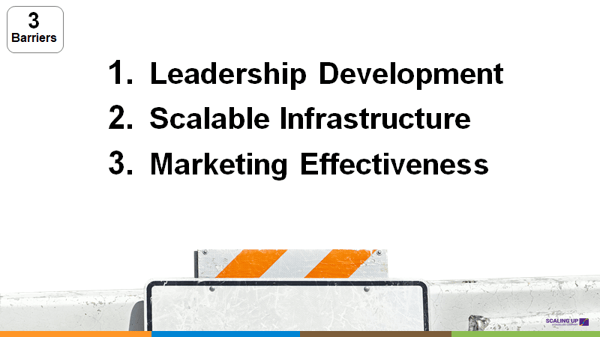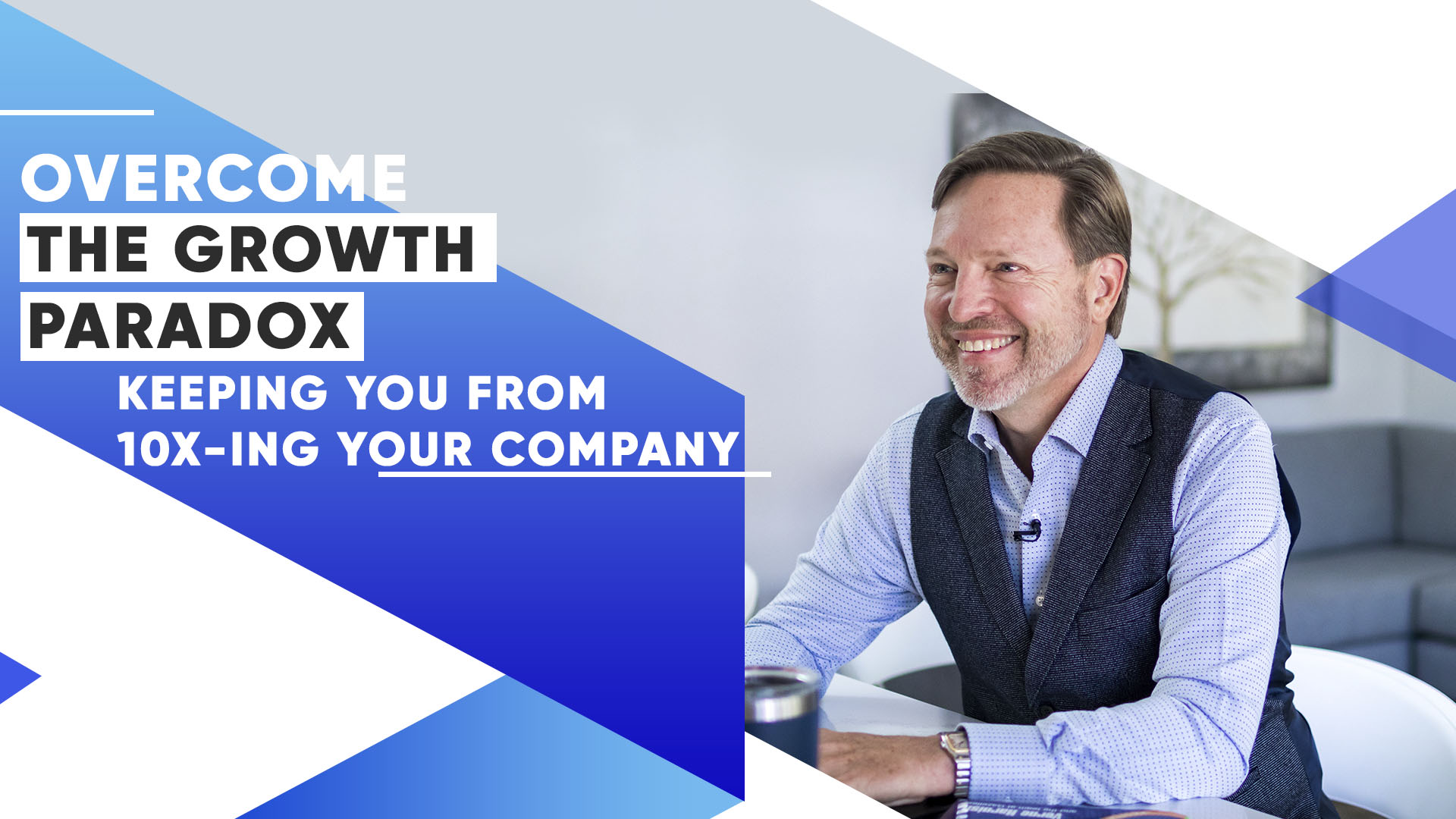3 Growth Engines You Can’t Ignore If You Want To Scale
.png)
If there’s one thing that we’ve seen businesses wholeheartedly focusing on this past year, it’s efficiency.
That’s what scaling is essentially all about: how to scale more efficiently as the world throws more curveballs at you.
I made this a major focus of my work early in my career when I was building out the Birthing of Giants leadership program at MIT.
I kept seeing this common set of 3 barriers - or “growth killers” - that were constantly getting in the way of companies scaling.
Today, I want to cover these “growth killers” with you and show you how to turn them into “growth engines” for your business.
To Scale, You Need To Stabilize These 3 “Growth Killers”
It starts with what’s between our ears and the importance of leadership development.
2. Scalable Infrastructure
Here it’s the ability to get a scalable infrastructure - just figuring out where everyone’s going to set, getting computer systems in place, and getting the networks to work and communicating with each other.
3. Marketing
And then marketing - this is an especially critical function if you want to scale. But all 3 are equally important.
So, let’s start with marketing and then work backwards.
#3 You Need Effective Marketing To Drive Growth
Marketing is not just about selling products or services. It’s about attracting talent, attention, investors and the key relationships that will help you grow.
When I was first starting out, I wanted to build one of the biggest entrepreneurial organizations in the world.
So I reached out to Regis Mckenna. Regis was one of the big technology marketing gurus who had also helped mentor Steve Jobs and authored Relationship Marketing.
I called him up, asked him if he was willing to help and he agreed. (He still likes to joke that I was one of his only free clients.)
It was Regis that taught me a few of my first major lessons about marketing.
As the leader, I believe your marketing focus should start with these 3 things:
1. Set time aside just for marketing
2. Work your list of 25 key people
3. Upgrade to the 4 E’s of Marketing
#1 Make Time For Marketing
You’ve got to have at least one hour set aside for marketing that’s separate from sales.
I’m still amazed at how many companies lump sales and marketing into the same meeting.
In my opinion, the title of someone who is VP of Sales and Marketing really doesn’t exist, because these functions are 2 different skill sets.
Sales is all about relationships and relationship-building. And marketing is much more of an analytic function. A very analytical person is what you need if you want to drive effective marketing.
So here, the question is:
Do you have a regular marketing meeting that is separate from sales and is it at least an hour?
#2 List Out Your Top 25 Relationships
When I worked with Regis, he advised me to start with the #1 agenda item that should be set for this regular meeting. 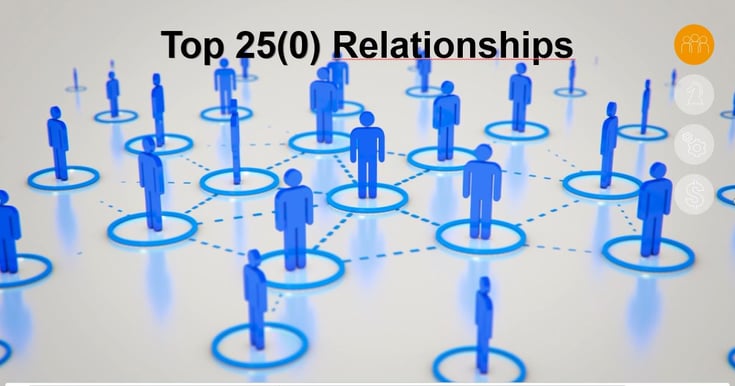
Take out a piece of paper and make a list of the top 25 relationships – influencers, brands, etc. – that you need to realize your vision.
Being an entrepreneur, you may have already learned this: Most industries are small and there are a couple hundred key players that really make each industry's activities move.
At the top of my list was Ronald Reagan – I wanted him to be the first president to utter the word entrepreneur. No other president had even used the term before that. I really wanted to start at the very top. Why not?
I filled out that list of 25 names and we spent a couple hours a week trying to figure out how to attract these people.
As a leader, it's your ability to build key relationships within your industry that is most important if you want to scale.
Let me refer to Am I Being Too Subtle?, which is a book by Sam Zell, a real estate entrepreneur from Chicago.
It’s a spectacular read. The main takeaway is what Sam does to work his list.
He’s got his own list of key people in his industry. And every year he creates a music box and reworks a popular song with it and sends it to the 400 people on his list. 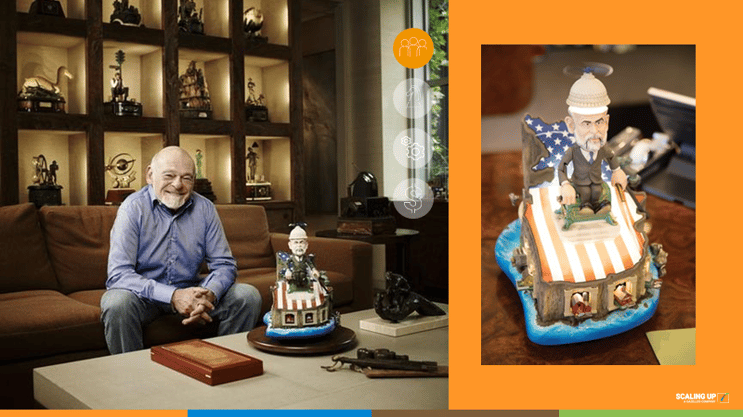
I learned recently that Tom Cruise does something similar with this particular cake – a $200 cake that he sends out to people that he knows well in the industry. It’s no surprise to me that he’s managed to maintain such a strong presence out in the movie business.
Here, the two questions for you are:
What is your top 25 list?
What are you doing to work that list on a daily basis?
#3 Move From The 4 P’s of Marketing to The 4 E's
It used to be called the 4 Ps of Marketing, coined by David Ogilvy. Now they’ve been updated into the 4 Es of Marketing.
Here are the new 4 E's and how to keep them top of mind. 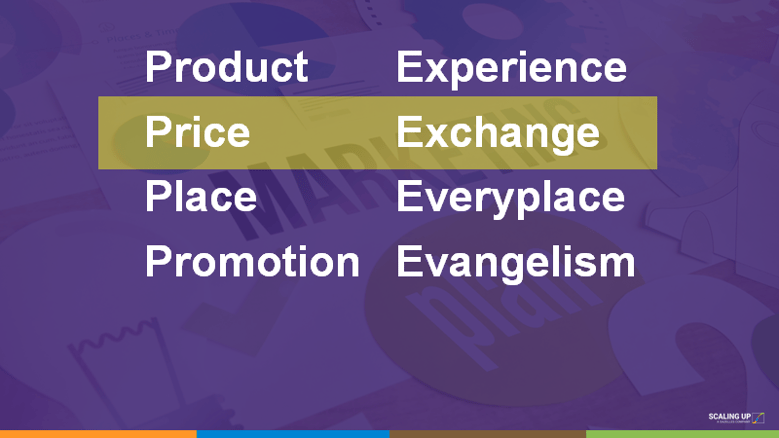
(1) From Product to Experience
Initially the focus was around your product or your service.
But now it’s much more about Experience.
You can have a great product or service, but if the experience is bad then it can really kill the entire growth of your business.
This first E is about taking that first idea of relationship management and combining it with making sure that every touchpoint of your business is a great experience.
This is what Steve Jobs was going for when he released the iPod in 2001 and launched his own retail stores. It was all about making sure that even the box that it comes with is a great experience.
(2) From Price to Exchange
The next one is Exchange. This means that there is no fixed price anymore and now we’ve been able to move to demand-based pricing.
Uber and Lyft operate in this way. The price for a ride will change in a dynamic way. It’s the same way with airlines and flight tickets. At any given time you might need something more than at other times, so you’re willing to pay more or less.
We coached a Silicon Valley eCommerce company that was doing $190 million in revenue in 2019. They were getting ready to send out 2 million catalogues with a lot of fixed prices in them.
Our coaching team came in and talked them out of sending those catalogues out and shredding all of them. They then revamped some of the catalogues and moved them to the web so they could be more demand based.
The result? Their EBITDA went from 8 million in 2019 to over 40 million. They achieved over a five-fold increase by just getting smarter about pricing!
Business today is about understanding how to use Price to sell what you have and not sell what you don’t have.
The reason we get pricing so wrong is that we are selling to people and people are not logical. They’re psychological. 
Take the simple touchpoint of selling wine on a menu. All you have to do is reverse the order of the wine options on the menu and on average revenue will rise by 26%.
Even more, if you anchor that list with really expensive bottles of wine you can pull revenue up by 250%!
It’s quite amazing just how a few simple adjustments to your pricing model can affect your business. I don’t have the space here to go further, but you can do a deeper dive with these resources that I recommend:
- Dr Victoria Medvec and her High Stakes Negotiations Master Business Course with Growth Institute. Or you can also get the book. I’ve made more money from that class than any other that we offer, including my own.
- The Good, Better, Best Approach to Buying HBR Article by Rafi Mohammed
- Confessions of a Pricing Man by Herman Simon
- Influence by Dr. Robert Cialdini - This is one of the top 5 business books I think we all ought to read.
(3) From Place to Everyplace
Instead of place, it's really about Everyplace.
You want to make sure that wherever your core customers are, you need to be every place they are. You want to feel ubiquitous.
If they’re hanging out on Instagram, you better be there.
(4) From Promotion to Evangelism
When it comes to promotion we can’t exactly afford a Superbowl ad, so you have to rely on raving fans.
People are so rabid about products that their fanatic devotion does all the promotion that’s needed. In many cases, you only need 1,000. The key is to have internal Evangelists and then scale outward.
#2 Build Scalable Infrastructure That Organizes Brainwork
Now, let’s address the complexity that will arise as you scale up and hire more team members and serve more clients.
When it comes to teams, the optimum size is about 4-5 people. When you’re scaling, you have to figure out how to organize the people on your teams.
It’s easy when you’re getting started because you have this small team of 4-8 people and you’re all kind of just hanging out and building your business. But when you’re scaling, you have to figure out how to organize the people.
People will want their own space in the office and you need to figure out how to get around this new paradigm.
In the old days it was all about organizing the muscle.
If you look at the traditional org chart, that’s how it looks. You’ve got the head, and the muscles, and the toes. 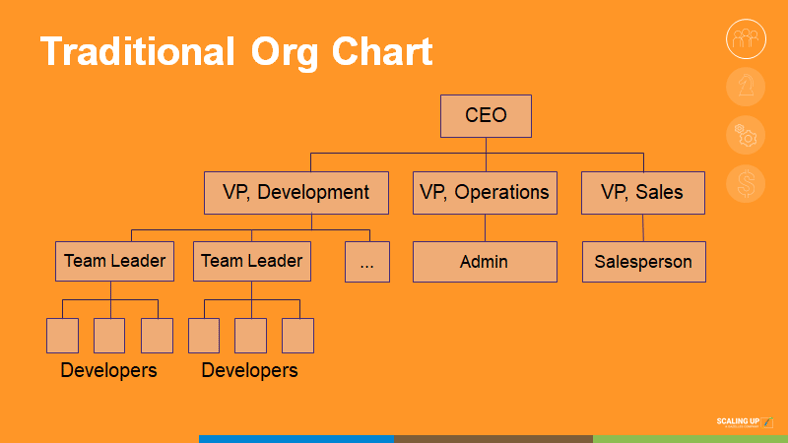
But we’re a long way from organizing muscle power in our organizations. Today, we’re organizing brain power.
Usually with this traditional organization chart, people are very happy at the top and it just gets sadder as they move down.
Today, it’s more about the minds than the muscle. If we’re going to organize brainwork, then your organization needs to organize like the brain would. The brain is structured and looks more like a web with individual neurons all interconnected within it. This is how quick decisions are made.
The new org structure is what we call the agile scale up – this is the org chart of the 21st century..png?width=800&name=image-png-Feb-16-2021-12-40-55-78-AM%20(1).png)
I want to refer to this book by Gary Hamel, Humanocracy.
I named this book the #1 Business Book of 2020. And not just that. I think this will be the most important book written this decade.
In his book, Gary begins to detail how real companies are operating in this agile scale up model. 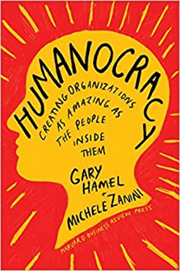
One case study he dives into is the healthcare provider Buurtzorg, founded by nurse Jos de Blok. Jos and his founding team didn’t want to have a system where nurses reported to an area nurse who reports to a district nurse who reports to a regional nurse and so on.
Instead, they scaled on this new org approach.
Today, they have 14,000 nurses and nurse assistants led by 50 leaders at headquarters and 18 coaches total.
We don’t need managers in the 21st century. What we do need is coaches.
Next, I’ll point you to Ron Lovett who wrote Outrageous Empowerment.
Ron scaled a company to 1500 private security guards and he got rid of all the middle managers. He put the guards into special forces teams and had only 8 leaders managing the company from headquarters, including himself. This way, things get done so much quicker and it becomes a lot easier to scale.
At Google, teams that are more effective than others have these 2 things in common.
1. Everyone gets equal talk time
2. And we get to know everybody on a more personal level
This ability to organize people into small teams, make them run effectively and then get out of their way is the future of work in the 21st century.
#1 Leadership Development Keeps You Ahead
Leadership development is the #1 barrier in the organization.
We all suffer from the “tower of guilt”, that stack of books and articles sitting on your plate that you just haven’t cleared through yet. 
Bill Gates realized that the only way he and his company were going to remain relevant was to invest in their own development.
The key is to change from being a “know it all” culture to a “learn it all culture”.
Mark Cuban has this habit that for about 3 hours everyday he reads and his goal is to mine just one idea that he can use that will help one of his many companies.
Warren Buffett has consistently beat the market by a factor of 10 for 5 decades. When asked how this is possible, Warren’s partner Charlie Munger said that Warren’s first priority has always been to reserve much time for quiet reading and thinking no matter how old he gets.  In his 20s, Henry McGovern decided to go to Poland and open up the first Pizza Hut. Twenty five years later he retired as CEO AmRest International with 49,000 employees and 300 restaurants across 16 countries.
In his 20s, Henry McGovern decided to go to Poland and open up the first Pizza Hut. Twenty five years later he retired as CEO AmRest International with 49,000 employees and 300 restaurants across 16 countries.
When he got his leaders together to celebrate what he had accomplished, he said that the reason they had made it is because "we’re more a training company than we are a restaurant company”.
Near the end of his life, Steve Jobs himself launched Apple University, an executive learning program within Apple to help employees think more like Steve.
Your company will only grow to the extent that it is capable of learning and developing.
And it’s not just our development as leaders, but it’s the development of everyone in the organization that’s important.
Get After It
Someone asked me a really great question recently that had me thinking, and it was this:
"What type of pep talk would you prepare to inspire coworkers to keep learning and training?"
I hope to the extent that all the examples above made sense, this article itself was the pep talk. But it does sadden me that in the US, we’ve somehow devalued the importance of education.
Most of the rest of the world will literally walk miles to have the right to be able to learn. It’s a privilege and I’ve never thought that you would have to motivate somebody to get educated. Honestly, if somebody was not a learner, I wouldn’t hire them.
In my own book Scaling Up, I reference around 40 other books. That’s intentional, because I hardly have all the answers.
As leaders, we’re learners. And in our world, we’re either winning or we’re learning. So one thing I want to leave with is to encourage you to at least learn enough that you want to take a deep dive.
At some point you’ll have to take a deep dive. Because it’s going to get really hard to scale without that critical side of practical learning.


